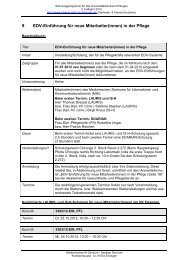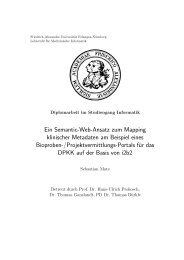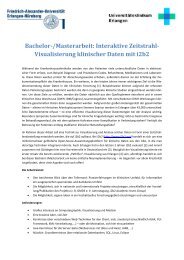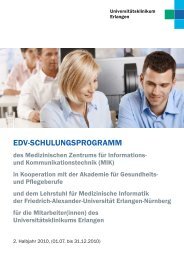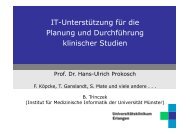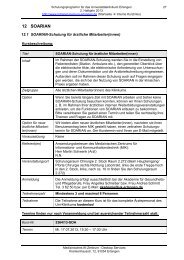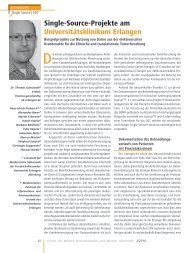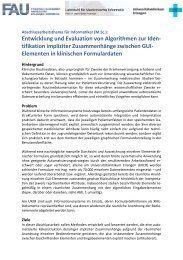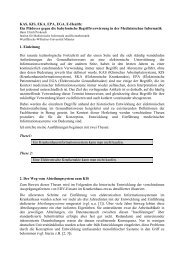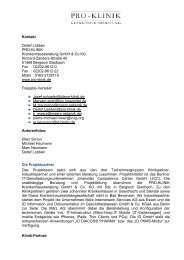Set of PPT presentation slides
Set of PPT presentation slides
Set of PPT presentation slides
You also want an ePaper? Increase the reach of your titles
YUMPU automatically turns print PDFs into web optimized ePapers that Google loves.
Large-Scale Integration <strong>of</strong><br />
Assessment Form Data<br />
With RDF Networks<br />
Sebastian Mate<br />
12.12.2012
Sebastian Mate // Department for Medical Informatics // University <strong>of</strong> Erlangen-Nuremberg<br />
Background: The DPKK i2b2 Project<br />
Reuse <strong>of</strong> EMR Data in a Shared Research Database<br />
EMR Member A<br />
EMR Member B<br />
Erlangen<br />
KAS DPKK-Mitglied A<br />
Münster<br />
KAS DPKK-Mitglied B<br />
PSA:<br />
PSA:<br />
PSA:<br />
PSA:<br />
NEW!<br />
EMR database<br />
ETL<br />
EMR database<br />
Original<br />
DPKK database<br />
NEW!<br />
i2b2-System<br />
DPKK Researcher<br />
DPKK Researcher<br />
2
Sebastian Mate // Department for Medical Informatics // University <strong>of</strong> Erlangen-Nuremberg<br />
Background: The DPKK i2b2 Project<br />
Reuse <strong>of</strong> EMR Data in a Shared Research Database<br />
Orbis (Münster)<br />
Soarian (Erlangen)<br />
PSA:<br />
PSA:<br />
Orbis (Bonn)<br />
PSA:<br />
i2b2<br />
Shared research DB<br />
3
Sebastian Mate // Department for Medical Informatics // University <strong>of</strong> Erlangen-Nuremberg<br />
Background: The DPKK i2b2 Project<br />
Reuse <strong>of</strong> EMR Data in a Shared Research Database<br />
Soarian (Erlangen)<br />
PSA:<br />
Orbis (Münster)<br />
PSA:<br />
Data Access to Heterogeneous<br />
Source Systems, Interfaces<br />
Orbis (Bonn)<br />
PSA:<br />
i2b2<br />
Data Protection,<br />
Privacy<br />
Semantic Interoperability,<br />
Mapping, Ontology,<br />
Interface Terminologies,<br />
Standard Re<strong>presentation</strong> for Clinical Data<br />
DPKK dataset<br />
4<br />
Shared research DB<br />
Common Data Elements,<br />
Elegibility criteria<br />
Patient Identification,<br />
Data Presentation and Visualization
Sebastian Mate // Department for Medical Informatics // University <strong>of</strong> Erlangen-Nuremberg<br />
EMR vs. WWW<br />
5
Sebastian Mate // Department for Medical Informatics // University <strong>of</strong> Erlangen-Nuremberg<br />
Properties <strong>of</strong> Heterogeneous Data in Medical<br />
Documentation And The World Wide Web<br />
Paper-based<br />
documentation<br />
• Sometimes ;-) human-readable<br />
• Understandable for humans<br />
• Not machine-readable<br />
• Not machine-processible<br />
Electronic documentation<br />
(EMR)<br />
• Human-readable<br />
• Understandable for humans<br />
• Machine-readable<br />
• Not efficiently machineprocessible<br />
• Heterogeneous data<br />
• Distributed storage<br />
World Wide Web<br />
• Human-readable<br />
• Understandable for humans<br />
• Machine-readable<br />
• Not efficiently machineprocessible<br />
• Heterogeneous data<br />
• Distributed storage<br />
6
Sebastian Mate // Department for Medical Informatics // University <strong>of</strong> Erlangen-Nuremberg<br />
Developing a New Data Integration Approach<br />
Challenges<br />
Problem 1: How to align and merge data from independent sources?<br />
EMR in Münster: AGFA ORBIS<br />
EMR in Erlangen: Siemens Soarian<br />
• Different data structures (different EMR vendors)<br />
• Similar information (full prostate cancer documentation in EMR)<br />
7
Sebastian Mate // Department for Medical Informatics // University <strong>of</strong> Erlangen-Nuremberg<br />
Developing a New Data Integration Approach<br />
Challenges<br />
Problem 2: How to efficiently access and process the huge piles <strong>of</strong><br />
data elements?<br />
Data:<br />
• Structured<br />
• Uncoded<br />
8<br />
Erlangen as an example: > 70,000 data elements<br />
(including data element versioning)
Sebastian Mate // Department for Medical Informatics // University <strong>of</strong> Erlangen-Nuremberg<br />
Background: Digging for Gold<br />
How to Access Clinical Databases?<br />
Talend<br />
Tools / Data Access<br />
Layer<br />
Data / Storage Layer<br />
9
Sebastian Mate // Department for Medical Informatics // University <strong>of</strong> Erlangen-Nuremberg<br />
Background: Digging for Gold<br />
… is very tedious at the Tools/S<strong>of</strong>tware/ETL Layer!<br />
10
Sebastian Mate // Department for Medical Informatics // University <strong>of</strong> Erlangen-Nuremberg<br />
Background: Digging for Gold<br />
Why is it so tedious?<br />
• While technical access to the databases is easy, semantically correct reuse <strong>of</strong> the data is a<br />
very difficult, tedious task<br />
• Little attention regarding the reuseability has been paid when the forms have been created<br />
• Primary goal was to replace paper-based documentation, not to support data reuse<br />
• EMRs do not <strong>of</strong>fer functions to allow semantic annotations, only simple forms<br />
• Giant pile <strong>of</strong> data elements (> 70,000 in the Erlangen EMR)<br />
• Forms are designed for the human to be read but not to be processed by a machine<br />
• Clinicians know how to interpret relationships between different data elements. These are,<br />
however, documented nowhere!<br />
• In a cross-institutional scenario: Disparate Source Systems<br />
• Different system architectures, database systems<br />
• Electronic documentation has evolved independently for each source system<br />
• Different clinical background<br />
• Available data elements differ<br />
11
Sebastian Mate // Department for Medical Informatics // University <strong>of</strong> Erlangen-Nuremberg<br />
Background: Digging for Gold<br />
Why is it so tedious? => Example from Erlangen<br />
studies a patient can<br />
be enrolled in<br />
date <strong>of</strong> enrollement<br />
cycles<br />
stagings & results<br />
Semantic relations between<br />
CRF elements<br />
12
Sebastian Mate // Department for Medical Informatics // University <strong>of</strong> Erlangen-Nuremberg<br />
Background: Digging for Gold<br />
Need for Knowledge Management<br />
Ontology / Knowledge<br />
Base Layer<br />
Talend<br />
Tools / Data Access<br />
Layer<br />
Data / Storage Layer<br />
13
Sebastian Mate // Department for Medical Informatics // University <strong>of</strong> Erlangen-Nuremberg<br />
Working at the Ontology layer:<br />
… if done right, it can be very efficient!<br />
14
Sebastian Mate // Department for Medical Informatics // University <strong>of</strong> Erlangen-Nuremberg<br />
Our Ontolgy-Based Approach<br />
A system for accessing heterogenious EMR data<br />
• Uses OWL ontologies to describe data providing source systems (EMR), target systems (i2b2)<br />
and the mappings in between<br />
• Declarative, machine processible description <strong>of</strong> all information<br />
• Vision: future linkage with other biomedical ontologies / Semantic Web<br />
• Supports the annotation <strong>of</strong> typical relationships between CRF data elements in order to<br />
post-construct a hospital-wide ontology/MDR<br />
• For Erlangen: post-annotation <strong>of</strong> relationships between 42,000 data elements<br />
• Operates on a generic EAV-like data model to support the easy processing <strong>of</strong> these<br />
relationships<br />
• Mappings can be „simple“ or „complex“ including support for full data transformations and<br />
filtering<br />
• Theoretical support for all relational database systems and database operations<br />
• Mappings are transformed into SQL scripts to extract the data from the source systems<br />
(EMR) and export the data into the target system (here: i2b2)<br />
15
Sebastian Mate // Department for Medical Informatics // University <strong>of</strong> Erlangen-Nuremberg<br />
Methods: Ontology Mapping<br />
… with Semantic Web techniques<br />
My Project<br />
MyProject_Item<br />
• PSA<br />
• Gleason 3<br />
Gleason3<br />
PSA<br />
Target Ontology<br />
The target dataset (the data we want to use for research purposes) is expressed<br />
by a target ontology.<br />
16
Sebastian Mate // Department for Medical Informatics // University <strong>of</strong> Erlangen-Nuremberg<br />
Methods: Ontology Mapping<br />
… with Semantic Web techniques<br />
Gleason1<br />
Gleason2<br />
Pathology_Item<br />
Pathology Form<br />
Gleason 1:<br />
PSA:<br />
Gleason 2:<br />
PSA value:<br />
PSA_value<br />
Target Ontology<br />
The source system (the data we have), i.e. the EMR, is expressed by a source<br />
ontology.<br />
17
Sebastian Mate // Department for Medical Informatics // University <strong>of</strong> Erlangen-Nuremberg<br />
Methods: Ontology Mapping<br />
… with Semantic Web techniques<br />
Gleason3<br />
PSA<br />
ADD<br />
Gleason1<br />
Gleason2<br />
PSA_value<br />
PSA:<br />
Target Dataset<br />
Target Ontology Mapping Ontology Source Ontology Source System<br />
• We can then create a mapping ontology to connect concepts from the target<br />
ontology to concepts from the source ontology.<br />
• Some concepts can be mapped directly,<br />
• others might require transformations and/or data filtering, which can be<br />
expressed with intermediate nodes.<br />
18
Sebastian Mate // Department for Medical Informatics // University <strong>of</strong> Erlangen-Nuremberg<br />
Methods: Ontology Mapping<br />
… with Semantic Web techniques<br />
Gleason3<br />
PSA<br />
ADD<br />
Gleason1<br />
Gleason2<br />
PSA_value<br />
PSA:<br />
Target Dataset<br />
Target Ontology Mapping Ontology Source Ontology Source System<br />
• Administrative knowledge: The data element „Gleason3“ is not captured in the<br />
source system (EMR), but it is needed to answer research questions.<br />
• Medical knowledge: The Gleason Score 3 is the sum <strong>of</strong> Gleason Score 1 and 2.<br />
• Technical knowledge: To export the data element „Gleason3“, you need to add<br />
the data elements „Gleason1“ and „Gleason2“.<br />
19
Sebastian Mate // Department for Medical Informatics // University <strong>of</strong> Erlangen-Nuremberg<br />
Methods: Ontology Mapping<br />
… with Semantic Web techniques<br />
Gleason3<br />
PSA<br />
hasImport<br />
ADD<br />
Gleason1<br />
Gleason2<br />
PSA_value<br />
Target Ontology<br />
Mapping Ontology<br />
Source Ontology<br />
• Intermediate nodes are limited to two operands in order to keep the<br />
operations simple and „semantically atomic“.<br />
• The distinction between the two relations hasOperand1 and hasOperand2<br />
enables the correct processing order <strong>of</strong> non-commutative operations.<br />
20
Sebastian Mate // Department for Medical Informatics // University <strong>of</strong> Erlangen-Nuremberg<br />
Methods: Ontology Mapping<br />
… with Semantic Web techniques<br />
GREATER<br />
A<br />
B<br />
Target<br />
IF<br />
SUBTR<br />
ADD<br />
C<br />
D<br />
E<br />
Target Ontology Mapping Ontology Source Ontology<br />
• This means: if A is greater than B, export (C + D) – E.<br />
• QuickMapp prefix notation:<br />
Target : IF (GREATER A B) (SUBTR (ADD C D) E)<br />
21
Sebastian Mate // Department for Medical Informatics // University <strong>of</strong> Erlangen-Nuremberg<br />
Methods: Approach Overview<br />
Target<br />
t=4<br />
IF<br />
t=3<br />
t=2<br />
SUBTR<br />
GREATER<br />
t=1<br />
ADD<br />
A<br />
B<br />
C<br />
D<br />
processing order<br />
E<br />
Target Ontology Mapping Ontology Source Ontology<br />
• To allow complex data transformations, nodes can be cascaded into „expression trees“.<br />
• OWL-to-SQL translation: For each mapping node, an SQL statement, which performs the<br />
operation expressed by the node, can be constructed automatically .<br />
22
Sebastian Mate // Department for Medical Informatics // University <strong>of</strong> Erlangen-Nuremberg<br />
Methods: OWL-2-SQL Translation<br />
Target<br />
t=4<br />
IF<br />
INSERT INTO TEMPTABLE(E, A, V)<br />
E<br />
SELECT OP1.E, „Sum…“, OP1.V + OP2.V<br />
FROM Target Ontology Mapping Ontology Source Ontology<br />
(SELECT E, A, V FROM …) OP1<br />
FULL OUTER JOIN<br />
How to process nodes<br />
(SELECT E, A, V FROM …) OP2<br />
ON OP1.E = OP2.E<br />
How to access data<br />
WHERE OP1.V IS NOT NULL AND …<br />
t=2<br />
SUBTR<br />
t=3<br />
GREATER<br />
t=1<br />
ADD<br />
A<br />
B<br />
C<br />
D<br />
23
Sebastian Mate // Department for Medical Informatics // University <strong>of</strong> Erlangen-Nuremberg<br />
Data Export<br />
Information to construct SQL statements<br />
24
Sebastian Mate // Department for Medical Informatics // University <strong>of</strong> Erlangen-Nuremberg<br />
Data Export<br />
SQL statement construction<br />
E A V<br />
OP1<br />
OP1.E<br />
OP1.A OP1.V<br />
OP2.E<br />
OP2.A OP2.V<br />
OP2<br />
(SELECT E, A, V FROM …) OP1<br />
(SELECT E, A, V FROM …) OP2<br />
Fetch Operand 1 data<br />
Fetch Operand 2 data<br />
25
Sebastian Mate // Department for Medical Informatics // University <strong>of</strong> Erlangen-Nuremberg<br />
Data Export<br />
SQL statement construction<br />
OP1.E OP1.A OP1.V<br />
OP2.E OP2.A OP2.V<br />
JOIN<br />
OP1.E<br />
A<br />
B<br />
C<br />
OP1.A OP1.V<br />
OP2.E<br />
A<br />
B<br />
C<br />
OP2.A OP2.V<br />
(SELECT E, A, V FROM …) OP1<br />
FULL OUTER JOIN<br />
(SELECT E, A, V FROM …) OP2<br />
ON OP1.E = OP2.E<br />
Join on entity<br />
(Patient)<br />
26
Sebastian Mate // Department for Medical Informatics // University <strong>of</strong> Erlangen-Nuremberg<br />
Data Export<br />
SQL statement construction<br />
OP1.E OP1.A OP1.V<br />
OP2.E OP2.A OP2.V<br />
JOIN<br />
OP1.E<br />
A<br />
B<br />
C<br />
OP1.A OP1.V<br />
2<br />
4<br />
OP2.E<br />
A<br />
B<br />
C<br />
OP2.A OP2.V<br />
2<br />
5<br />
4<br />
SELECT OP1.E, „Sum…“, OP1.V + OP2.V<br />
FROM<br />
(SELECT E, A, V FROM …) OP1<br />
FULL OUTER JOIN<br />
(SELECT E, A, V FROM …) OP2<br />
ON OP1.E = OP2.E<br />
WHERE OP1.V IS NOT NULL AND …<br />
Transformation<br />
Filter criteria<br />
27
Sebastian Mate // Department for Medical Informatics // University <strong>of</strong> Erlangen-Nuremberg<br />
Data Export<br />
SQL statement construction<br />
OP1.E<br />
A<br />
B<br />
C<br />
OP1.A OP1.V<br />
2<br />
4<br />
OP2.E<br />
A<br />
B<br />
C<br />
OP2.A OP2.V<br />
2<br />
5<br />
4<br />
E<br />
A<br />
B<br />
A<br />
…<br />
…<br />
V<br />
4<br />
9<br />
INSERT INTO TEMPTABLE(E, A, V)<br />
SELECT OP1.E, „Sum…“, OP1.V + OP2.V<br />
FROM<br />
(SELECT E, A, V FROM …) OP1<br />
FULL OUTER JOIN<br />
(SELECT E, A, V FROM …) OP2<br />
ON OP1.E = OP2.E<br />
WHERE OP1.V IS NOT NULL AND …<br />
Write result into<br />
temporary table<br />
28
Sebastian Mate // Department for Medical Informatics // University <strong>of</strong> Erlangen-Nuremberg<br />
Summary and Tools<br />
CSV file<br />
„Virtual“ Source System<br />
OntoGen<br />
Target Dataset<br />
Source System<br />
Gleason3<br />
PSA<br />
ADD<br />
Gleason1<br />
Gleason2<br />
PSA_value<br />
PSA:<br />
Target Ontology<br />
Mapping Ontology<br />
Source Ontology<br />
OntoEdit<br />
QuickMapp<br />
OntoExport<br />
i2b2<br />
Alternative workflow to integrate CSV files if access to the source system is not available.<br />
29
Sebastian Mate // Department for Medical Informatics // University <strong>of</strong> Erlangen-Nuremberg<br />
30
Sebastian Mate // Department for Medical Informatics // University <strong>of</strong> Erlangen-Nuremberg<br />
31
Sebastian Mate // Department for Medical Informatics // University <strong>of</strong> Erlangen-Nuremberg<br />
32
Sebastian Mate // Department for Medical Informatics // University <strong>of</strong> Erlangen-Nuremberg<br />
33
Sebastian Mate // Department for Medical Informatics // University <strong>of</strong> Erlangen-Nuremberg<br />
Soarian Form Rendering Service<br />
Ontology & Form Navigation<br />
34
Sebastian Mate // Department for Medical Informatics // University <strong>of</strong> Erlangen-Nuremberg<br />
Soarian Form Rendering Service<br />
Drag&drop ontology construction<br />
35
Sebastian Mate // Department for Medical Informatics // University <strong>of</strong> Erlangen-Nuremberg<br />
Results<br />
Three different scenarios (numbers are outdated)<br />
Orbis (Münster)<br />
Soarian (Erlangen)<br />
Soarian (Erlangen)<br />
Soarian (Erlangen)<br />
PSA:<br />
PSA:<br />
PSA:<br />
PSA:<br />
DWH<br />
CSV<br />
DWH<br />
Soarian<br />
i2b2<br />
i2b2<br />
i2b2 Urology<br />
i2b2<br />
i2b2 Polyprobe<br />
i2b2<br />
temporary database<br />
DPKK database<br />
GTDS<br />
36<br />
Cancer registry
Sebastian Mate // Department for Medical Informatics // University <strong>of</strong> Erlangen-Nuremberg<br />
Results: Ontology Mapping for DPKK<br />
Results between Münster and Erlangen<br />
• Preliminary results for Münster and Erlangen (166 DPKK concepts, also see<br />
MIE2011 paper):<br />
37
Sebastian Mate // Department for Medical Informatics // University <strong>of</strong> Erlangen-Nuremberg<br />
Discussion<br />
The Future <strong>of</strong> this Project<br />
• TODO/Vision: split into Client/Server architecture<br />
• Server stores only one large ontology for central knowledge management<br />
• Simplifies administrative aspects (who is allowed to edit the ontology?)<br />
• Optimizations<br />
• Improve processing order <strong>of</strong> intermediate nodes (similar to compiler<br />
construction)<br />
• Integration with Talend OpenStudio to simplify support for multiple<br />
database systems? (Project with University <strong>of</strong> Göttingen)<br />
• Use various tricks to let the DMBS do its own SQL optimizations<br />
• Evaluate „super nodes“ concept (graph-based optimizations)<br />
38
Sebastian Mate // Department for Medical Informatics // University <strong>of</strong> Erlangen-Nuremberg<br />
Discussion<br />
The Future <strong>of</strong> this Project<br />
• Further developments<br />
• Model the target ontology in a generic form (not only i2b2-specific)<br />
• Add further relationships to the target ontology (isAttributeOf, isValueOf,<br />
describesNonexistanceOf, describesExistanceOf, …)<br />
• Enable modeling <strong>of</strong> complex relationships between data elements<br />
• Allow mappings at different hierarchy levels<br />
• Allow abstract mappings without useing tricks (e.g. check for the existance <strong>of</strong><br />
a form)<br />
39
Sebastian Mate // Department for Medical Informatics // University <strong>of</strong> Erlangen-Nuremberg<br />
Discussion<br />
Vision 1: linkage to other ontologies<br />
Hospital Ontolgy<br />
i2b2 project 2<br />
taxonomy<br />
i2b2 project 2<br />
taxonomy<br />
40
Sebastian Mate // Department for Medical Informatics // University <strong>of</strong> Erlangen-Nuremberg<br />
Discussion<br />
Vision 2: A Client/Server Architecture<br />
i2b2 Target<br />
Taxonomy<br />
Source System<br />
Ontology<br />
Hospital<br />
Ontology<br />
EHR Form<br />
Renderer<br />
Search &<br />
Navigation<br />
Properties Editor Mapping Editor Source System<br />
Annotation
Sebastian Mate // Department for Medical Informatics // University <strong>of</strong> Erlangen-Nuremberg<br />
Thanks for Listening!<br />
i2b2 Target<br />
Taxonomy<br />
Source System<br />
Ontology<br />
Hospital<br />
Ontology<br />
EHR Form<br />
Renderer<br />
Search &<br />
Navigation<br />
Properties Editor<br />
Mapping<br />
Editor<br />
Source System<br />
Annotation<br />
42
Sebastian Mate // Department for Medical Informatics // University <strong>of</strong> Erlangen-Nuremberg<br />
Backup / Additional Slides<br />
43
Sebastian Mate // Department for Medical Informatics // University <strong>of</strong> Erlangen-Nuremberg<br />
Ontology Mapping: PSA Example<br />
=> see MIE2011 paper!<br />
Task: export the last PSA value. If none <strong>of</strong> the above fields has been filled out,<br />
export the separate field.<br />
4x<br />
1x<br />
44
Sebastian Mate // Department for Medical Informatics // University <strong>of</strong> Erlangen-Nuremberg<br />
Ontology Mapping: PSA Example<br />
=> see MIE2011 paper!<br />
45
Sebastian Mate // Department for Medical Informatics // University <strong>of</strong> Erlangen-Nuremberg<br />
Data Export<br />
Real world SQL code construction example<br />
46
Sebastian Mate // Department for Medical Informatics // University <strong>of</strong> Erlangen-Nuremberg<br />
Data Export<br />
Real world SQL code construction example<br />
47
Sebastian Mate // Department for Medical Informatics // University <strong>of</strong> Erlangen-Nuremberg<br />
A few mapping examples<br />
The source table<br />
48
Sebastian Mate // Department for Medical Informatics // University <strong>of</strong> Erlangen-Nuremberg<br />
A few mapping examples<br />
ADD: adding two values (both must not be NULL)<br />
Sum : ADD TestScore1 TestScore2<br />
49
Sebastian Mate // Department for Medical Informatics // University <strong>of</strong> Erlangen-Nuremberg<br />
A few mapping examples<br />
“Tolerant“ ADD (2nd operarand may be NULL)<br />
Sum : ADDT TestScore1 TestScore2<br />
50
Sebastian Mate // Department for Medical Informatics // University <strong>of</strong> Erlangen-Nuremberg<br />
A few mapping examples<br />
“Very Tolerant“ ADD (both values may be NULL)<br />
Sum : ADDVT TestScore1 TestScore2<br />
51
Sebastian Mate // Department for Medical Informatics // University <strong>of</strong> Erlangen-Nuremberg<br />
A few mapping examples<br />
Accessing unstructured text (simple NLP)<br />
Smoker : INSTR PatientNotes „Morleys“<br />
Smoker : INSTR PatientNotes „lung cancer“<br />
Smoker : INSTR PatientNotes „smoking“<br />
Smoker : INSTR PatientNotes „smoke“<br />
Smoker : INSTR PatientNotes „cigarettes “<br />
...<br />
52
Sebastian Mate // Department for Medical Informatics // University <strong>of</strong> Erlangen-Nuremberg<br />
A few mapping examples<br />
Accessing unstructured text (String manipulations)<br />
Greetings : TAIL (HEAD PatientNotes<br />
SUBTR (STRPOS PatientNotes „]“) „1“))<br />
(ADD (STRPOS PatientNotesValue „[“) „1“)<br />
53
Sebastian Mate // Department for Medical Informatics // University <strong>of</strong> Erlangen-Nuremberg<br />
Results: Ontology Mapping for DPKK<br />
Results between Münster and Erlangen<br />
• Impossible mappings<br />
• Erlangen: One mapping required<br />
access so SAP IS-H (to get the<br />
patient age), the system currently<br />
only support one source system at a<br />
time<br />
• Impractical mappings<br />
• Erlangen/Münster: calculation <strong>of</strong><br />
time intervals between two data<br />
elements (operation and detection<br />
<strong>of</strong> metastases)<br />
Problem: mapping at the values<br />
level (including versioning) would<br />
result in 108 distinct mappings for<br />
Erlangen!<br />
54<br />
We need to create mappings<br />
at various hierarchy levels<br />
6 mappings each<br />
4 mappings<br />
each
Sebastian Mate // Department for Medical Informatics // University <strong>of</strong> Erlangen-Nuremberg<br />
Results: Ontology Mapping for DPKK<br />
Results between Münster and Erlangen<br />
• „A small trick“: cheating our own system<br />
Four mappings required to check whether a form has been created or not (ignoring what<br />
data has been filled in). The mapping system does not support this. Dirty solution:<br />
„Simulate“ an other source system table (ErlangenSTGSoarianTable_FormExistence),<br />
which does not reurn real data, but „True“ if any data element from this form exists.<br />
=> The ontology describes a table, which doesn‘t exist in reality!!!<br />
55<br />
We need to create „abstract“ mappings!
Sebastian Mate // Department for Medical Informatics // University <strong>of</strong> Erlangen-Nuremberg<br />
Results: Ontology Mapping for DPKK<br />
Results between Münster and Erlangen<br />
56
Sebastian Mate // Department for Medical Informatics // University <strong>of</strong> Erlangen-Nuremberg<br />
Results: Ontology Mapping for DPKK<br />
Results between Münster and Erlangen<br />
• Another small trick:<br />
In Erlangen, the DPKK project required prefiltering the patients‘ data with a<br />
view to model a relation between one concept and all other DPKK concepts.<br />
=> Important information is not stored inside the ontology!<br />
Again: We need to allow<br />
mappings at various<br />
hierarchy levels<br />
57
Sebastian Mate // Department for Medical Informatics // University <strong>of</strong> Erlangen-Nuremberg<br />
Results: Mapping for Urology<br />
Impossible Mappings<br />
studies a patient can<br />
be enrolled in<br />
All other data<br />
elements<br />
How can we model such<br />
complex relationships?<br />
58
Sebastian Mate // Department for Medical Informatics // University <strong>of</strong> Erlangen-Nuremberg<br />
i2b2-specific Target Ontology<br />
59
Sebastian Mate // Department for Medical Informatics // University <strong>of</strong> Erlangen-Nuremberg<br />
EAV data model to support relationships between<br />
data elements<br />
Default relationships<br />
Form head<br />
Relationships<br />
which can be used to<br />
override the default<br />
relationships<br />
Form body<br />
hasDocumentID<br />
hasPatientID<br />
hasCaseID<br />
DocumentID PatientID CaseID DateStartValue DateEndValue Attribute Value<br />
42 753753 457789 12.05.2010 12.05.2010 Attribut A: 4,3<br />
42 753753 457789 12.05.2010 12.05.2010 Attribut B: 22<br />
42 753753 457789 12.05.2010 12.05.2010 Startzeitpunkt<br />
Attribut B:<br />
42 753753 457789 12.05.2010 12.05.2010 Endzeitpunkt<br />
Attribut B:<br />
23.02.2010<br />
25.02.2010<br />
60
Sebastian Mate // Department for Medical Informatics // University <strong>of</strong> Erlangen-Nuremberg<br />
EAV data model to support relationships between<br />
data elements<br />
Default relationships<br />
Form head<br />
Relationships<br />
which can be used to<br />
override the default<br />
relationships<br />
Form body<br />
hasDocumentID<br />
hasPatientID<br />
hasCaseID<br />
DocumentID PatientID CaseID DateStartValue DateEndValue Attribute Value<br />
42 753753 457789 12.05.2010 12.05.2010 Attribut A: 4,3<br />
42 753753 457789 23.02.2010 25.02.2010 Attribut B: 22<br />
42 753753 457789 12.05.2010 12.05.2010 Startzeitpunkt<br />
Attribut B:<br />
42 753753 457789 12.05.2010 12.05.2010 Endzeitpunkt<br />
Attribut B:<br />
23.02.2010<br />
25.02.2010<br />
61
Sebastian Mate // Department for Medical Informatics // University <strong>of</strong> Erlangen-Nuremberg<br />
„Super Nodes“ Concept<br />
62
Sebastian Mate // Department for Medical Informatics // University <strong>of</strong> Erlangen-Nuremberg<br />
Discussion<br />
Temporal Aspects<br />
Time<br />
Lab reports<br />
EHR forms<br />
Case ID<br />
PatientID<br />
63



